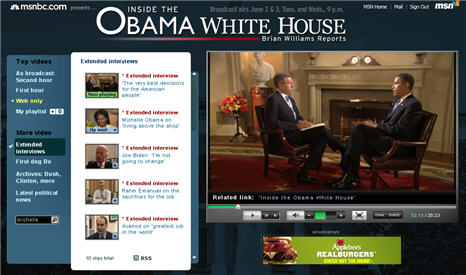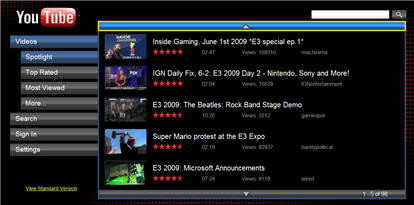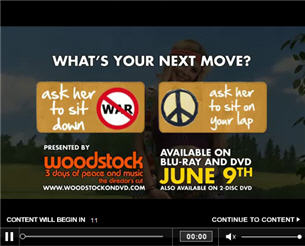-
Two More Great Examples of Online Video's Growing Pervasiveness
Spending half a day in New York City yesterday provided two more great examples of online video's growing pervasiveness.
First, as I was hustling down Seventh Avenue toward Penn Station to catch my train back to Boston, a billboard for "Peter Arthur Stories" caught my attention. It was one of those gigantic multi-story billboards that wrapped around a building and are frequently used to promote new films. But there was something slightly different about it - it seemed like an ad for a film, but it didn't have any actors' images or rating or "in theaters now." I was intrigued and made a mental note to check it out.
It turns out that "Peter Arthur Stories" is actually an online-only series of 4 short (6-8 minutes) episodes produced by the Pennsylvania Tourism Office which was released a few weeks ago. The series traces Peter Arthur (note his initials are "PA," also the abbreviation for Pennsylvania), as he traipses around the state in a sidecar searching for the waitress he's obsessed over since she served him a slice of Shoofly pie when he was 12 years-old. You see the state's lush landscape, farmlands and towns like Gettysburg and Jim Thorpe through his eyes and experiences. There's a campy but catchy musical score that is interwoven at various points. At the series' web site there's also a 4 question trivia contest which enters you into a sweepstakes for 12 different Pennsylvania getaways.
It's certainly a very unconventional campaign for a state tourism office. Think about it - the state bought hugely expensive billboard in a prime, heavily-trafficked Manhattan location solely to drive people to a web site to see its originally-produced video that only subtly promotes the state. That the state pursued this plan speaks volumes about how pervasive and accepted online video has become as a promotional medium. I have no idea if the campaign has worked for the state, but I give the people behind it huge credit for being on the leading edge.
My other experience came at an awards lunch I attended, at which David Walker, former U.S. Comptroller General and now president of the Peter G. Peterson Foundation was the featured speaker. Some of you may know that Walker has become the most outspoken critic of the U.S. government's financial policies and the debts that it has racked up
After giving a 15 minute talk, Walker implored the audience to learn more and get involved. How? He held up a DVD cover for the movie "I.O.U.S.A." and said go to http://www.iousathemovie.com/ and watch the 30
 minute excerpt of this documentary, and then pass it along to your friends and family. I.O.U.S.A. is an 87 minute educational film that has been called "The Inconvenient Truth of Debt." As a sidenote, I watched part of the excerpt; it really is pretty frightening what's happening with America's finances.
minute excerpt of this documentary, and then pass it along to your friends and family. I.O.U.S.A. is an 87 minute educational film that has been called "The Inconvenient Truth of Debt." As a sidenote, I watched part of the excerpt; it really is pretty frightening what's happening with America's finances. Walker's recommendation is yet another illustration of how activists have turned to online video to generate excitement and action. In the old days passing a petition around to gather signatures was the way incent change; increasingly the tactic of choice is to distribute an online video and build a community around it.
Online video is becoming more pervasive and mainstream; it has far more potential than just being another entertainment outlet.
What do you think? Post a comment now.
Categories: Indie Video
Topics: I.O.U.S.A., IOUSA, Pennsylvania Tourism Office, Peter Arthur Stories
-
Robust Ecosystem Promises that Online Video Will Keep Looking Better and Better
I continue to be impressed with the ecosystem of technology companies whose products enable online video to be delivered better, cheaper and faster. Video quality has made incredible strides over the last ten years, evolving from grainy postage stamp-sized experiences to gorgeous HD or near-HD experiences that are becoming more routine. This is causing a powerful "virtuous cycle" to take hold: as users' video experiences improve they watch more video. As they watch more they help fuel more investment in the online video medium.
In particular, CDNs' ability to offer better service even as their delivery rates continue to plummet is based on continuous improvements in their infrastructure. Similarly, content providers' ability to offer higher-quality video is based on improving operational efficiencies and costs in their content management and publishing processes. Two announcements today illustrate both of these dynamics quite well.
First, Blackwave, a Boston-area early-stage provider of video storage and delivery systems that I've been following for a while, is announcing today the R6, its first production system, along with its first major CDN customer, CDNetworks. Last week, Andrew Grant, Blackwave's director of business development and Mike Killian, CTO gave me an update,
Blackwave's focus in on giving CDNs a more powerful, more efficient way of storing and serving high-
 quality video content. The R6 reduces the CDN's hardware requirements by offering both higher-density and more intelligent storage. One example is that Blackwave continuously gauges the popularity of certain pieces of content. If their popularity increases, more resources are provisioned for higher-availability; if their popularity decreases (as for Long Tail content), they get fewer resources. Among other things, Blackwave is also able to support WMS and Flash streaming, FTP uploading for content ingest and "multi-tenancy" for customer resource sharing.
quality video content. The R6 reduces the CDN's hardware requirements by offering both higher-density and more intelligent storage. One example is that Blackwave continuously gauges the popularity of certain pieces of content. If their popularity increases, more resources are provisioned for higher-availability; if their popularity decreases (as for Long Tail content), they get fewer resources. Among other things, Blackwave is also able to support WMS and Flash streaming, FTP uploading for content ingest and "multi-tenancy" for customer resource sharing.The net effect of all this is that Blackwave believes it can deliver 10x improvements in both capex (through lower hardware requirements) and opex (through lower power, cooling, data center costs). All of this of course means that CDNs gain more financial flexibility to deliver ever higher quality content from their customers.
Separate, thePlatform (note a VideoNuze sponsor) is announcing today that it is launching mpsManage Ingest, a new streamlined feature for ingesting its customers' content. Marty Roberts, thePlatform's VP of Marketing told me last week that as video quality has increased - thereby causing an explosion of file sizes - the time and effort to ingest them has grown more burdensome and costly. This is particularly true for companies with large or dynamic video libraries.
mpsManage Ingest sets up "Watch Folders" where customers push their content via FTP, a feed reader for thePlatform to subscribe to updates and multi-format ingest adaptors. mpsManage Ingest carries no extra charge, and continues the company's recent efforts to lower the total cost of operating for video content providers (see earlier post on thePlatform's mpsManage Storage and mpsManageCDN offerings).
These are just two examples of how improved technology is enabling higher-quality video. There's plenty more happening; I recently received a briefing from Nokeena, which provides video caching, streaming and delivery intelligence for delivery across screens, a category that includes others like Verivue and EdgeWare, which I haven't spoken to yet. Then there is adaptive bit rate streaming from companies like Move Networks, Adobe and Microsoft, efficient transcoding from companies like Grab Networks, HD Cloud, mPoint and Encoding.com and file transfer and work flow acceleration from companies like Aspera and Signiant.
Adding it all up, the ecosystem of technology helping enable higher-quality, more efficient delivery of online video is impressive and its momentum is growing. Users will continue to benefit from all of these initiatives, as the quality line between conventional delivery and online delivery further blurs.
What do you think? Post a comment now.
Categories: CDNs, Technology
Topics: Blackwave, EdgeWare, Nokeena, thePlatform, Verivue
-
June 24th Webinar on Video Syndication
Please join me on Wednesday June 24th at 1:30pm EDT / 10:30am PDT for a free webinar, "Demystifying Online Video Syndication." As VideoNuze readers know, I've been writing about the emergence of the "syndicated video economy" for over a year now. During this time syndication has continued to grow in importance for all video content producers and technology providers. I hear almost daily about how strategic syndication has become for reaching fragmented online audiences.
I'll be sharing updated trends and data on video syndication, as well as thoughts on where the market is heading. The webinar is sponsored by Grab Networks, whose co-president Marcien Jenckes will provide information on its grabMediaOS solution that enables a "Create Once, Publish Anywhere" business model. Grab was formed from the Fall '08 merger of Anystream and Voxant and it recently announced a $12M financing. Grab works with hundreds of content providers and is one of the key players in driving the video syndication market.
If you're trying to understand the syndication opportunity and identify the right solutions to fit your needs, this webinar is for you!
Categories: Events, Syndicated Video Economy
Topics: Grab Networks
-
A New Old Model for Making Money with Original Online Entertainment Video
Today I'm pleased to introduce "VideoNuze Forums," a periodic opportunity for online video industry experts to contribute their thoughts and ideas to the VideoNuze community. I'm a firm believer that only through the industry's collective ideas and energy will online video reach its ultimate potential.
In this kickoff post, David Graves shares his thoughts on how advertisers can collaborate with online video producers to fund original online entertainment, while leveraging the syndication model. David is a veteran media executive who I've known for years; he's served in executive roles at Yahoo and Reuters, and more recently founded PermissionTV. He's now consulting with Global Capital Strategic Group.
Please contact me if you're interested in contributing. I can't guarantee I'll run everything, but I welcome your ideas.
A New Old Model for Making Money with Original Online Entertainment Video
by David Graves
In the very beginning of television, advertising agencies worked directly with creative people to produce the dramatic programs they wanted to put their ads in. Now, 60 years later, it's time for them to do so again, on the Web.
Between then and now, distributors such as TV networks have become the ones who financed and controlled video programming and acted as the middleman between creatives and advertisers. But today there aren't enough distributors with both the will and the resources to speculatively fund large volumes of online entertainment video.
There are many creative people who would like to produce for the new online medium, particularly now that it can be done for historically low costs. But it's hard to make money. Even so, some dramatic video like Strike.TV is getting produced on the hopes that it will attract an audience that might get sold to advertisers. This is nice but inefficient and usually unprofitable.
In order for the Internet to develop as a substantial platform for original entertainment video, a new model has to form that gives producers some additional upfront confidence. There needs to be a better chance of generating a profit in order to encourage Internet producers to produce and people with money to fund them. Since the paid model is still highly challenged, even for well-known, branded fare (e.g. broadcast network programs), advertising is the most likely source of revenue.
Advertisers are clearly open to the potential benefits of online video advertising. To begin with, they love TV commercials over every other form of advertising. Online, their ads can't be skipped, can be better targeted and offer the possibility of an immediate response or interaction on top of the branding value. What's not to like?
But experiments with advertiser-created programming have by and large been disappointing. That's because it doesn't make sense for advertisers to be the ones financing, creating or distributing video. It's not what they do. On the other hand, partnerships like that of Alloy Entertainment and Johnson & Johnson, to create the "Private" Web series for teen girls, which debuts next month, exemplifies the potential. Brands like Neutrogena will be subtly integrated into the shows.
The model that will work is one where advertisers hook up directly with creative programmers to help encourage show ideas they like. Some call this "branded entertainment" and it can take many forms. For example, it could be an advertising commitment at an agreed-upon CPM, contingent on seeing the finished product. Or a pre-buy that helps fund the production in return for a lower CPM. Even a smile and a wink would have value.
If a producer had an embedded advertiser at a decent CPM, they could arrange for distribution both on their own sites and through syndication. Given the state of ad sales today, offering syndicated sites free, high-quality video content with a built-in CPM split would be like offering the proverbial candy to a baby. Further, there will be syndicators like Pixsy and others who would no doubt be happy to take on the job of arranging distribution for a slice of the CPM.
This model is very similar to the way TV stations have been getting their first run syndicated content (like Oprah and Wheel of Fortune) for years. The programs come with a certain number of embedded commercials along with slots that the stations can sell themselves. It's called "syndicated barter." There are many advertisers who have used this method to ensure that their ads run in the right editorial environment. What they end up paying is the aggregate rating that the individual stations generate.
For original online video entertainment to flourish it seems inevitable that producers and advertisers will need closer partnerships to address the vacuum created by the lack of distribution funding.
What do you think? Post a comment now.
Categories: Advertising, Indie Video, Syndicated Video Economy, VideoNuze Forums
Topics: Alloy, Johnson & Johnson, Pixsy
-
VideoNuze Report Podcast #19 - June 5, 2009
Below is the 19th edition of the VideoNuze Report podcast, for June 5, 2009.
Daisy was in New York this week for the "NewFronts," a day-long meeting that Digitas sponsored, mainly for independent online video creators and media buyers/agencies. The goals were to educate the market and fuel advertiser interest. Daisy reports that despite the mixed news coming out of the independent video world this year, it was an upbeat gathering.
I provide additional detail on Microsoft's announcement this year of new entertainment-oriented features for XBox 360. The gaming console continues to take on more of a convergence positioning, with new instant-on 1080p video, live streams, Zune integration, etc. With an installed base of 30 million users, Microsoft has a prime opportunity to drive convergence and get a video foothold. The new Xbox 360 features coincide with last week's Hulu Desktop announcement and this week's YouTube XL unveiling.
Click here to listen to the podcast (14 minutes, 47 seconds)
Click here for previous podcasts
The VideoNuze Report is available in iTunes...subscribe today!
Categories: Advertising, Aggregators, Devices, Indie Video, Podcasts
Topics: Digitas, Hulu, Microsoft, NewFronts, Podcast, XBox, YouTube
-
MSNBC Gets It Right with "Inside the Obama White House" Minisite
NBC and MSNBC nicely executed their "Inside the Obama White House" minisite, built to accompany this week's exclusive 2 night special, which itself boosted NBC's ratings. The minisite offers all the broadcast programming, chunked into logical parts. There's also web-only video, searchable clips and playlist functionality. The minisite presents the video in a very digestible, clear manner, so if you forgot to TiVo the special like me, you don't miss anything.
When you begin playing the video there's a pre-roll for Applebee's, which appears to be the primary sponsor, though Sprint has some banners too. Mid-rolls run after most segments and then the next programming segment resumes. Applebee's awareness is very strong, though I think they could have benefited from varied creative (I certainly won't forget its Steakburgers and Carside service)
One other random observation - if you look at the segment that the image below is captured from, you'll see that NBC's Brian Williams and President Obama appear to be wearing the exact same tie..pretty funny!Categories: Broadcasters
-
YouTube XL Reflects Google's Browser-Centric Worldview
YouTube's announcement this week of "YouTube XL," an optimized version of its site meant for viewing on larger screens caught my attention as it appeared to be another building block in broadband-to-the-TV convergence. I spoke with Chris Dale, a YouTube spokesman to learn more.
On the one hand YouTube XL is a great offering for early adopters who have connected their computers directly to their TVs. XL offers large, easy-to-use navigation that scales depending on the size of your display and HD video quality. And Chris added that given Chrome and Android compatibility, XL creates some very cool functionality. Some video isn't yet rights-cleared, that will likely change over time. XL builds on the "YouTube for Television" initiative introduced in January for Sony PS3 and Nintendo Wii.
On the other hand, long-term, XL is a limited-appeal offering, because it reflects Google's browser-centric worldview. As Chris explained, from CEO Eric Schmidt on down, there's a conviction that the "browser as the platform" is going to dominate entertainment and information distribution. This is certainly the way the online world works today, as practically all of broadband-delivered video is consumed within a browser context. (In fact, this is one of the things that made last week's Hulu Desktop announcement so noteworthy, a large aggregator introducing an app that breaks the browser-only paradigm.)
The problem is that historically at least, the non-online, TV world hasn't been browser-based. Instead, various set top boxes (whether from cable/satellite/telco or from newer convergence players) rely on their own applications to present and manage video. Given this disconnect, new convergence devices and services will instead need to rely on YouTube APIs if they want to access YouTube's vast trove of content, unless they start building in browsers. This is how AppleTV, Sony Bravia, TiVo and others have worked with YouTube in the past. My concern is how much investment attention will convergence-oriented APIs be getting from YouTube when the company's emphasis is clearly on the browser.
Back in March '08, I wrote, "YouTube: Over-the-Top's Best Friend" in which I asserted that for emerging convergence devices and video service providers, YouTube would be the perfect partner. It has the best-known video brand, the largest catalog and the best promotional reach. I still believe that. YouTube could be a formidable disruptive force in over the top if it had a strategy to do so. With its browser focus though, it's hard to see that happening.
In these tough economic times, I don't blame YouTube, or others, from prioritizing. However, my sense is that by taking a more passive approach to convergence, YouTube is opening the door a little wider for others like Netflix who are more aggressively pursuing convergence opportunities, as well as incumbents like Comcast and Time Warner Cable who are just getting going on bridging broadband video to their set-top boxes. As the clear online video market share leader, YouTube has a pretty golden opportunity to aggressively chart new ground and cause likely market disruption. That it's choosing not to means others have a little less pressure on them.
What do you think? Post a comment now.
Categories: Aggregators, Devices
-
Tremor vChoice Ad Format Raises the Bar on Pre-rolls
I was intrigued by news yesterday from Tremor Media, the ad network and management company, of their rollout of a new ad format called vChoice. Advertising continues to be the primary business model for premium online video, yet there's wide consensus that pre-roll ads, the most popular ad format today, leaves a lot to be desired. I spoke to Tremor's CEO, Jason Glickman to learn more about vChoice, and its benefits vs. pre-roll.
With vChoice, there's still a video ad playing prior to the requested content, but at 5-15 seconds, it's shorter than typical 15 and 30 second spots. The big difference is that this short ad is meant to be a teaser; when it stops running, an explicit choice is given to the user to click for more video, or to continue on to the requested content.
By shortening the upfront message, and presenting more options to the user, the goal is to deepen engagement. vChoice is geared to advertisers who either already have videos that could be logically clustered and offered to users (e.g. a car model which multiple promo videos) or are interested in creating new stories for non-linear consumption (like the example below from Warner Bros). Either way, as Jason notes, vChoice offers much greater creative freedom and engagement potential than a typical 15 or 30 second passive spot.
Tremor just finished a beta of vChoice with Microsoft, P&G, Ubisoft and Warner Bros. The results are impressive: 200% lift in engagement, as defined by multiple metrics, and a click-through rate of 3-6% vs. sub-1% for typical pre-rolls. Tremor's also using Quantcast data to provide demographic profiling of these engaged users. The early results, plus the creative potential, is what Jason says has advertisers most excited.
Jason also added that there are two keys to making vChoice possible: the company's Acudeo management platform, which allows multiple in-stream ads to run within a single unit, while also delivering full analytics, and the scale represented by 900+ sites in Tremor's publisher network. Importantly, there's no extra charge for additional views in a vChoice experience. That means for users who watch multiple videos, the advertiser's cost/impression keeps declining.
Jason doesn't see vChoice obsoleting pre-rolls, but rather offering more value in the online video medium. vChoice's success depends on whether users will be sufficiently enticed by the enhanced choices the advertiser offers to divert from their original viewing intentions. Key to driving that behavior is getting media buyers and creatives to understand the new value of these units and to then to invest in them. As this happens, the full potential of online video advertising will begin to be realized.
What do you think? Post a comment now.
Categories: Advertising
Topics: Tremor Media






